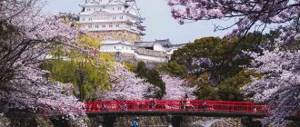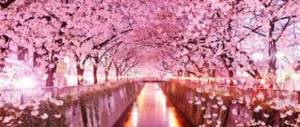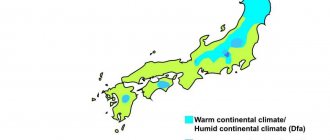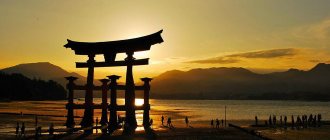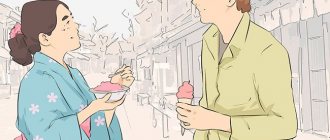The Japanese archipelago consists of hundreds of islands stretching from north to south. Such geography provides the country with climatic diversity, so there is no single concept of the Japanese climate. The climate in Japan varies significantly depending on the region. In January, when there is frost and snow in the north, sakura blooms in the southern regions, and the average temperature does not fall below 10-15 degrees Celsius.
A land of contrasts: frosts and subtropics
The climatic zones of Japan are strikingly diverse: almost all types of climate are represented here. The four main islands stretch from north to south for 3 thousand km: Hokkaido, Honshu, Kyushu, Shikoku. The northern part of Hokkaido is located in the subarctic zone, and the south of the country is already in the subtropics.
Since the country is surrounded on all sides by the ocean, the weather has its own characteristics. In winter, wet monsoons constantly blow from the Eurasian continent, bringing rain and snow to the western part of the archipelago. During this time, the eastern Pacific coast is mostly clear and dry.
Spring begins with strong winds blowing in February-March. These are the first signs of the spring season.
Climatic conditions on the largest islands - Honshu, Shikoku and Kyushu - are milder than in the north. Winters are warm, temperatures do not drop below zero, although there are heavy snowfalls. At the beginning of summer, monsoon rains begin, humidity reaches 100%.
From mid-summer to early autumn, temperatures reach +30 Celsius and above, attracting vacationers to the beaches. At the end of September the heat subsides and the number of tourists increases.
Typhoons, which appear from June to October, causing destruction and danger to people's lives, are considered a real disaster for the climate of the islands.
The famous island of centenarians - Okinawa
Many people believe that living to be 100 years old and remaining with a clear mind is just some kind of fantasy. But residents of the island of Okinawa claim that this is quite normal and real.
The main secret of Okinawa's long-livers is proper nutrition and an active lifestyle. Optimism, climatic conditions and the cultural life of the Japanese play an important role.
Okinawans are leaders in life expectancy. They argue that food should not be too high in calories. Their diet consists mainly of plant foods. When it comes to food, island residents prefer vegetables and fruits. They also eat rice, seafood and tofu. Okinawans eat very little meat; they mostly eat pork.
Okinawans say that in order to always be healthy and beautiful, you should adhere to the following lifestyle:
- eat only healthy and low-calorie foods;
- eat fish in large quantities, as it contains Omega-3 acids and fish collagen;
- engage in martial arts or any other sport;
- rejoice in every day you live and thank the higher powers for it;
- communicate with your relatives and friends as often as possible;
- do nothing in haste and fuss;
- spend more time in nature and breathe clean and fresh air;
- drink infusions of medicinal herbs.
It is these aspects that make up the Japanese secret of longevity. The food system of Okinawans is designed so that they are always full and satisfied and have an ideal figure and health.
Winter in Japan
The winter months are especially different from region to region. So, in Hokkaido, especially in the northern part of the island, there is a fairly severe snowy winter, and the temperature can drop to 15-20 degrees below zero.
It is quite warm in Honshu and Shikoku in December-January: +5…+7 degrees. The Ryukyu Islands and Okinawa are located in southern latitudes; a monsoon climate prevails here and the temperature rarely drops below 10-12 degrees Celsius.
The Pacific coast has a mild climate: with the onset of winter, the air temperature here drops, but it rarely drops below zero. At the same time, in Northern Japan, snow falls from the first days of December, which lies there throughout the winter; in the center of the country, precipitation is extremely rare, and in the south there is no snow at all.
When you come to Japan in winter, you can first go skiing in Sapporo, and then go to Okinawa and scuba dive.
The weather in Japan by winter months in the main cities of the country looks like this:
| December | January | February | |
| Tokyo | +8…+11 | +6…+9 | +8…+10 |
| Kyoto | +9…+11 | +5…+7 | +9…+11 |
| Osaka | +8…+10 | +5…+7 | +6…+8 |
| Nara | +5…+8 | +3…+6 | +4…+7 |
| Sapporo | -1… -2 | -2… -3 | -1… +1 |
Coniferous forests
They grow on podzolic soils and are very similar to Far Eastern forests. Spruce and fir predominate here. The vegetation of Hokkaido is slightly different. The virgin forest has been replaced by artificial plantings, which consists mainly of Hokkaido spruce and Sakhalin fir.
In the temperate climate zone, coniferous forests are replaced first by broad-leaved forests (oak, maple, hornbeam), and then by subtropical coniferous forests with amazing representatives. In the central parts of the state grow: Japanese cryptomeria, cypress, pine.
The coniferous forests of Japan are considered the northernmost habitat of monkeys in the world. In addition to them, there are fox, bear, raccoon dog, deer, hare, and weasel.
Rice. 2. Landscape in Japan
Spring in Japan
The Japanese are careful about their weather, as it often brings them a lot of problems. So, everyone is looking forward to strong winds in February-March - they are the ones, according to old beliefs, that bring spring.
In general, spring in Japan is warm and sunny. Throughout the entire territory, except for the northern regions, already in March the temperature reaches +10, and in April on the large islands the air is filled with the fragrance of flowering apricot trees and the legendary sakura. This period is called Hanami.
Thanks to the huge extent of the country from north to south, you can watch the blossoming of these amazingly beautiful trees for several months: on the islands of Okinawa and Kyushu, sakura blooms at the end of February, in Tokyo and Kyoto it begins to bloom at the end of March, and in Hokkaido - at the end April - early May.
Thus, the whole spring in Japan passes under the sign of “Time of admiring flowers.” If you're deciding when to go to Japan, it's hard to find a better time. At the end of May the air warms up to + 25…+ 30 degrees.
In spring, temperature indicators for the main cities of the country look like this.
| March | April | May | |
| Tokyo | +9…+11 | +15…+18 | +18…+21 |
| Kyoto | +10…+12 | +15…+18 | +20…+23 |
| Osaka | +9…+12 | +14…+17 | +18…+22 |
| Nara | +7…+11 | +12…+16 | +17…+22 |
| Sapporo | +1…+3 | +7…+10 | +11…+14 |
Summer in Japan
The summer period begins exactly on schedule: at the beginning of June. It is from the first month of summer that the heat begins, but the rainy season in Japan also begins in June. It rains frequently, heavily, and can last for weeks.
The Japanese don't really like their summer: these are the months when deadly typhoons strike. Humidity increases to 100%, and the heat is set at +28...+30 degrees and above.
July is characterized by a decrease in the amount of rain, humidity also decreases - up to 90%.
July and August are the best time for a beach holiday: only on the coast do the Japanese and guests of the Land of the Rising Sun escape the tropical heat and humidity. There are many holidays and excursions held in the resort towns of Japan. Going on an ocean cruise on a boat, you can watch whales.
The average temperature in summer is as follows:
| June | July | August | |
| Tokyo | +20…+25 | +26…+30 | +28…+30 |
| Kyoto | +26…+27 | +29…+31 | +30…+32 |
| Osaka | +22…+25 | +26…+29 | +27…+30 |
| Nara | +20…+24 | +25…+28 | +25…+29 |
| Sapporo | +16…+20 | +21…+25 | +23…+27 |
Interesting Facts
Eastern philosophy, closely intertwined, but not dissolved with Western values, creates an unprecedented background of life, forming a completely unique mentality and way of life of the inhabitants.
Here are some interesting facts about life in this country:
- Currently, there is a trend among women in Japan for crooked teeth. After paying huge amounts of money to dentists, they end up with long and protruding fangs.
- The country is distinguished by its life expectancy; today more than 65 thousand people live here, whose age has passed 100 years.
- There are legends about the ability of Eastern people to work. In Japan, career obsession is on the rise. Young people give up family, having children, and sometimes even sex in favor of work.
- In this regard, most residents work 12 hours a day with a six-day work week.
- People here are taught to work from an early age. Children in schools clean their own classrooms.
Autumn in Japan
The first signs of the onset of autumn can be observed in late August - early September, when the air temperature gradually begins to decrease, remaining on average at a comfortable 25 degrees in most regions of the country. And although on some days in September the temperature sometimes reaches +28...+30 degrees, in October on some days the temperature in the capital no longer exceeds +13...+15 degrees.
Humidity drops in autumn, the picture of nature withering is pleasing to the eye, while the weather is mild and warm. Chrysanthemums are blooming, maple leaves are blazing with fire. Many travelers choose autumn for their trip, when the country looks especially attractive.
Autumn temperature indicators:
| September | October | November | |
| Tokyo | +25…+28 | +20…+23 | +15…+18 |
| Kyoto | +26…+29 | +20…+23 | +16…+18 |
| Osaka | +23…+26 | +18…+21 | +13…+15 |
| Nara | +21…+25 | +16…+20 | +11…+14 |
| Sapporo | +19…+22 | +12…+15 | +6…+8 |
When is the best time to visit Japan?
When choosing a time to travel to Japan, it is best to look at the map where exactly you are going.
The most popular excursions in Japan are during cherry blossoms - in spring. You can come to Okinawa at the end of February to admire this spectacle, when there is still snow on the main territory of Russia.
The beginning of summer is a rainy period, unfavorable for tourism. In July–August there is less rain, but it becomes too hot and stuffy.
Those who are interested in surfing come in the summer to the resort of Kamakura, the Ryukyu Islands, and Okinawa. Coral reef lovers gather on Keramo Island.
The best time to holiday in Japan, according to many, is mid-autumn. In October, festivals of music, dance, and traditional Japanese arts are held.
One of the most spectacular festivals, the Jidai Matsuri, is held in Kyoto every year on October 22. This is a festive costume procession, a historical reconstruction of the imperial procession, attracting numerous tourists.
Japan looks very beautiful on the eve of the Christmas and New Year holidays. The north of the country is covered with snow, but the weather is quite warm.
There are three popular ski areas in Hokkaido - Niseko, Furano and Rusutsu - with developed infrastructure and slopes for skiers of all levels.
Lovers of winter swimming in thermal springs near Mount Fuji also come to Japan.
Reason #3: Sapporo Snow Festival (Yuki Matsuri)
Every February, Sapporo, the largest city in Hokkaido, hosts the Sapporo Yuki Matsuri (snow festival).
One of the world's best winter festivals, Yuki Matsuri is famous for its massive and impressive snow sculptures.
You can spend the whole day enjoying the painstaking work and creativity that goes into each sculpture. The spectacle becomes even more beautiful in the evening when the statues are illuminated.
In addition to snow sculptures, the snow festival offers a variety of activities for people of all ages, including concerts, culinary specialties, snow battles, ice slides, bars and much more.
To take part in the snow festival, you need to plan carefully, as Sapporo begins to fill up with snow lovers and travelers from all over the world within a few months.
